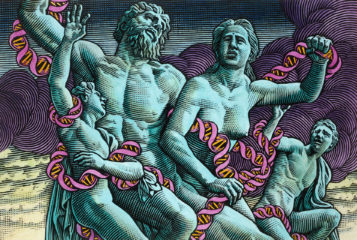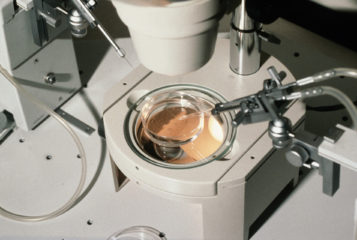Sex reassignment is an intricate and sensitive physiological, psychological, and social process that usually entails the loss of reproductive capacity. Reproductive technology can prevent this loss, but should it be used for that purpose? A recent case in Israel raises this question.
A young transgender man who was born as a female is requesting fertility preservation via ovarian tissue cryopreservation. The more routine technique of egg extraction is impossible since hormone replacement therapy has already disabled ovarian function.
The patient is about to go through sex reassignment surgery, and removal of the uterus and ovaries will be the first step of the surgical transition from female to male. He is requesting that the ovarian tissue removed during this procedure be preserved for possible future use (1).
The surgery has already been approved by an interdisciplinary committee, as required by Israeli regulations, but the requested permission for fertility preservation is being denied by the Israeli Ministry of Health, because 'it is not, to date, a standard procedure in Israel'.
Israeli regulations stipulate that ovarian cryopreservation is indicated in cases of 'girls or young women of reproductive age, who suffer from malignant conditions and are about to undergo oncological treatment that may harm their ovaries or prevent them from conceiving in the future, or in any other case in which a disease or a treatment may irreversibly harm reproductive function'.
Sex reassignment surgery arguably falls exactly under this description. The Ministry would be hard pushed to argue that sex reassignment is not a medical treatment, considering it is approved by a committee that operates under its auspices and is publicly funded as a medical procedure.
The Ministry also notes that the procedure is 'meant to preserve a woman's fertility for future self use'. Since sex reassignment involves a hysterectomy, the Ministry argues, it would not be possible to implant any future embryos in the patient's uterus, so 'self use' is impossible.
This, however, disregards the obvious possibility of employing a surrogate mother to carry the pregnancy, a procedure that would also be required in other cases in which a hysterectomy is medically indicated, such as uterine cancer. In all such cases the interpretation of 'self use' should be: 'use meant to create a genetically related child with the intent of raising that child as one's own', an interpretation that fully satisfies the underlying rationale of the regulation. The Ministry of Health's objections therefore seem to rest on shaky regulatory grounds.
In an appeal to the Israeli Supreme Court (2), the patient is now arguing that this objection can only be explained as an expression of a discriminatory attitude towards transgender persons. He further argues that denying access to fertility preservation in the context of sex reassignment violates not only a person's right to equal treatment, but also the right to healthcare and the right to procreate.
What would be the practical implications of fertility preservation during sex reassignment? Two possible scenarios emerge. In the first, the transgender man would remain single and therefore would need a surrogate and donated sperm in order to have a child. Legally, this procedure would not be authorised under Israeli surrogacy law because surrogacy agreements are only approved for couples when the sperm is that of the intended father. Ethically, this would be analogous to the more ordinary case of a single man who wishes to procreate with the help of a surrogate mother and donated egg.
In the second scenario, he would establish a relationship with a woman who would be willing to become pregnant with his child. In such a case, through sperm donation both intended parents would be biologically related to the child: the woman as a gestational mother, and the father as a genetic mother.
Theoretically, Israeli surrogacy law should permit this because it involves a couple who wish to raise a child together. Since the egg belongs to one of the parents, the principle of genetic relatedness to the child would be preserved (although the law stipulates that the sperm must belong to the father, which is of course impossible in this case). This scenario might be psychologically less complicated than regular surrogacy, since the gestational mother will also be the social mother. It might also be less complicated than regular egg donation, since the 'donor' (i.e. the father) 'stays in the family'.
However, should this scenario be considered in terms of surrogacy in the first place? We argue that a conceptual shift is required here. Rather than considering each individual in this scenario separately, which leads to the framing of the female partner as a surrogate, we should consider this through the lens of the couple's reproductive project. The couple, as the 'reproductive unit', already has the required egg and uterus; all they are missing is donated sperm.
This view of the couple as the relevant unit already exists in the context of reproductive technologies. For example, IVF is publicly funded in Israel up to the birth of two children from the current relationship, even if partners already have children from a previous relationship. This alternative framing allows us to sidestep the question of surrogacy and reveals that this second scenario is less complicated than it first seems.
From a biological perspective the second scenario is similar to another case that is currently being argued before an Israeli court in which a lesbian couple is requesting to use the egg of one woman to create the embryo, and the uterus of the other to carry it to term. The difference would be that in one case the child would have two social mothers, while in the other she would have parents of both genders. In both cases, we argue, the couple as a 'reproductive unit' should be allowed to pursue their reproductive goals and fertility preservation through sex reassignment should be permitted.
Yet, other possible arguments can be made against such a practice. For example, could there be negative implications for the identity of the prospective child? Should the source of the egg matter when considering the child's future wellbeing? What would be the psychological impact of growing up knowing that your social father is your genetic mother?
Although the situation might seem confusing, it is not necessarily more problematic than numerous others. Many children are born today to two mothers or two fathers; to a genetic mother who is not the birth mother (in surrogacy); to a birth mother who is not the genetic mother (in egg donation), and more. We doubt that this scenario would raise substantially new challenges to the child's identity.
Indeed, this novel reproductive scenario deserves the attention of bioethicists and would require appropriate counselling before and after birth. Nonetheless, we believe that healthcare and legal systems should acknowledge the reproductive rights of transgender individuals and promote their reproductive autonomy through the use of available fertility preservation techniques.
The authors would like to thank Gali Ben-Or, Anthony Morris and Maureen Morris for their helpful comments.
Sources and References
-
2) HCJ 2854/12 Â Ploni (John Doe) v Ministry of Health (Israeli supreme court sitting as a high court of justice)
-
1) De Sutter P. Gender reassignment and assisted reproduction






Leave a Reply
You must be logged in to post a comment.